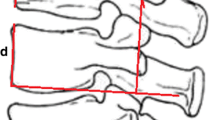Summary
To enhance the fusion of graft bone in thoracolumbar vertebrae and minimize the postoperative loss of correction, short-segment pedicle screw fixation was reinforced with posterior moselizee bone grafting in vertebrae for spinal fusion in patients with thoracrolumbar vertebrate fractures. Seventy patients with thoracrolumbar vertebrate fractures were treated by short-segment pedicle screw fixation and were randomly divided into two groups. Fractures in group A (n=20) were reinforced with posterior morselized bone grafting in vertebrae for spinal fusion, while patients group B (n=50) did not receive the morselized bone grafting for bone fusion. The two groups were compared in terms of kyphotic deformity, anterior vertebral height, instrument failure and neurological functions after the treatment. Frankel grading system was used for the evaluation of neurological evaluation and Denis scoring scale was employed for pain assessment. The results showed that the kyphosis correction was achieved in both group A and group B (group A: 6.4 degree; group B: 5.4 degree)/ At the end of follow-up, kyphosis correction was maintained in group A but lost in group B (P=0.0001). Postoperatively, greater anterior height was achieved in group A than in group B (P<0.01). During follow-up study, anterior vertebral height was maintained only in Group A (P<0.001). Both group A and group B showed good Denis pain scores (P1 and P2) but group A outdid group B in terms of control of severe and constant pain (P4 and P5). By Frankel criteria, the changes in neurological functions in group A was better than those of group B (P<0.001). It is concluded that reinforcement of short-segment pedicle fixation with morselized bone grafting for the treatment of patients with thoracolumbar vertebrae fracture could achieve and maintain kyphosis correction, and it may also increase and maintain anterior vertebral height. Morselized bone grafting in vertebrae offers immediate spinal stability in patients with thoracolumbar vertebrate fractures, decreases the instrument failure and provides better postoperative pain control than without the morselized bone grafting.
Similar content being viewed by others
References
Verlaan J J, Diekerhof C H Buskens E et al. Surgical treatment of traumatic fractures of the thoracic and lumbar spine. Spine, 2004,29(7):803–814
Wood K B, Bohn D, Mehbod A. Anterior versus posterior treatment of stable thoracolumar burst fractures without neurologic deficit: a prospective, randomized study. J Spinal Disord Tech, 2005,18(Suppl 1):S15–S23
Wang J G, Yang B, Yan X Z. Treatment of Thoracolumbar Fractures with Spinal Cord Injury Through Expansion and Laminoplasty by Vertebral Compression and Reconstruction of Interspinous and Supraspinous Ligament. J Weifang Med Col (Chinese), 2004,26(6):426–428
Kuner E H, Kuner A, Schlickewei W et al. Ligamentotaxis with an internal spinal fixator for thoracolumbar fractures. J Bone Joint Surg Br, 1994,76B:107–112
Frankel H L, Hancock D O, Hyslop G et al. The value of postural reduction in the initial management of closed injuries of the spine with paraplegia and tetraplegia: Part I. Paraplegia, 1969,7:179–192
Denis F, Armstrong G W, Searls K et al. Acute thoracolumbar burst fractures in the absence of neurologic deficit: A comparison between operative and nonoperative treatment. Clin Orthop, 1984,189:142–149
Hashimoto T, Kaneda K, Abumi K. Relationship between traumatic spinal canal stenosis and neurologic deficits in thoracolumbar burst fractures. Spine, 1988,13:1268–1272
Yang X G, Wang Z G, Zhu P F et al. Comparison among different internal fixation technique for the burst fracture of lumbar spine. Acta Acad Med Mil Tertiae (Chinese), 2000,22:29–32
Stancic M F, Gergorovic E, Nozica E et al. Anterior decompression and fixion versus posterior reposition and semirigid fixation in the treatment of unstable burst thoracolumbar fracture:prospective clinic trial. Croat Med J, 2001,42:49–53
Yuan W, Wang X W, Chen D Y et al. Treatment of lower lumbar fracture with the USS pedicel screw system. Chin J Orthop Trauma (Chinese), 2004,6:1229–1331
Author information
Authors and Affiliations
Corresponding author
Rights and permissions
About this article
Cite this article
Wang, J., Wu, H., Ding, X. et al. Treatment of thoracolumbar vertebrate fracture by transpedicular morselized bone grafting in vertebrae for spinal fusion and pedicle screw fixation. J. Huazhong Univ. Sci. Technol. [Med. Sci.] 28, 322–326 (2008). https://doi.org/10.1007/s11596-008-0321-4
Received:
Published:
Issue Date:
DOI: https://doi.org/10.1007/s11596-008-0321-4




